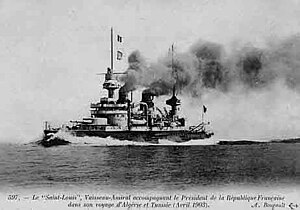French battleship Saint Louis
 Saint Louis in April 1903
| |
| History | |
|---|---|
| Name | Saint Louis |
| Namesake | King Louis IX of France |
| Builder | Arsenal de Lorient |
| Cost | 26,981,000 francs |
| Laid down | 25 March 1895 |
| Launched | 2 September 1896 |
| Completed | 1 September 1900 |
| Decommissioned | 8 February 1919 |
| Reclassified |
|
| Stricken | 29 June 1931 |
| Fate | Sold for scrap, 25 April 1933 |
| General characteristics | |
| Class and type | Charlemagne-class battleship |
| Displacement | 11,275 deep load ) |
| Length | 117.7 m (386 ft 2 in) |
| Beam | 20.3 m (66 ft 7 in) |
| Draught | 8.4 m (27 ft 7 in) |
| Installed power |
|
| Propulsion | 3 shafts, 3 triple-expansion steam engines |
| Speed | 18 knots (33 km/h; 21 mph) |
| Range | 4,200 miles (3,650 nmi) at 10 knots (19 km/h; 12 mph) |
| Complement |
|
| Armament |
|
| Armour |
|
Saint Louis was the last of the three Charlemagne-class pre-dreadnought battleships built for the French Navy in the mid-1890s. She spent most of her career assigned to the Mediterranean Squadron (escadre de la Méditerranée) and usually was chosen to serve as a flagship. The ship was involved in two accidental ramming incidents with two other French warships in her career, one of which sank a submarine.
When
Design and description
Saint Louis was 117.7 metres (386 ft 2 in)
The ship used three 4-cylinder vertical triple expansion steam engines, one engine per shaft. Rated at 14,500 PS (10,700 kW), they produced 14,900 metric horsepower (11,000 kW) during the ship's sea trials using steam generated by 20 Belleville water-tube boilers. Saint Louis reached a top speed of 18.5 knots (34.3 km/h; 21.3 mph) on her trials. She carried a maximum of 1,050 tonnes (1,030 long tons) of coal which allowed her to steam for 4,200 miles (3,600 nmi) at a speed of 10 knots (19 km/h; 12 mph).[1]
Saint Louis carried her main armament of four 40-
The Charlemagne-class ships carried a total of 820.7 tonnes (807.7 long tons)[4] of Harvey armour.[5] They had a complete waterline armour belt that was 3.26 metres (10 ft 8 in) high. The armour belt tapered from its maximum thickness of 400 mm (15.7 in) to a thickness of 110 mm (4.3 in) at its lower edge. The armoured deck was 55 mm (2.2 in) thick on the flat and was reinforced with an additional 35 mm (1.4 in) plate where it angled downwards to meet the armoured belt. The main turrets were protected by 320 mm (12.6 in) of armour and their roofs were 50 mm (2.0 in) thick. Their barbettes were 270 mm (10.6 in) thick. The outer walls of the casemates for the 138.6-millimetre (5.46 in) guns were 55 mm thick and they were protected by transverse bulkheads 150 mm (5.9 in) thick. The conning tower walls were 326 mm (12.8 in) thick and its roof consisted of 50 mm armour plates. Its communications tube was protected by armour plates 200 mm (7.9 in) thick.[4]
Construction and career

Saint Louis, named after King
The ship was assigned to the Mediterranean Squadron and arrived in Toulon on 24 September. Saint Louis became the squadron flagship on 1 October and retained that duty until 24 February 1904. She transported
On 25 June 1903, the ship received King
Less than two months later, she accidentally rammed and sank the submarine
World War I
Together with the older French pre-dreadnoughts, the ship's first mission in the war was to escort troop convoys from North Africa to France. On 23 September, Saint Louis was ordered to
By this time, however, naval operations were limited to bombarding Turkish positions in support of
Saint Louis was disarmed and decommissioned on 8 February and became a training ship for
References
- ^ a b Gille, p. 98
- ^ a b c d e f g h i j k l d'Ausson, p. 6
- ^ Caresse, pp. 114, 116–17
- ^ a b Caresse, p. 117
- ^ Chesneau and Kolesnik, p. 117
- ^ Silverstone, p. 111
- ^ Gille, pp. 97–98
- ^ Jordan & Caresse, p. 44
- ^ Caresse, p. 121
- ^ Caresse, p. 124
- ^ Caresse, p. 125
- ^ "Le submersible Vendémiaire a heurté le cuirassé Saint-Louis". Le Petit Journal (in French). 9 June 1912. Retrieved 29 June 2012.
- ^ Gille, pp. 98–99
Bibliography
- d'Ausson, Enseigne de Vaisseau de la Loge (1978). "French Battleship St. Louis". F. P. D. S. Newsletter. VI (1). Akron, Ohio: F. P. D. S.: 6–7. OCLC 41554533.
- Campbell, N.J.M. (1979). "France". In Gardiner, Robert (ed.). Conway's All the World's Fighting Ships 1860–1905. Greenwich, UK: Conway Maritime Press. pp. 283–333. ISBN 0-85177-133-5.
- Caresse, Philippe (2012). "The Battleship Gaulois". In Jordan, John (ed.). Warship 2012. London: Conway. ISBN 978-1-84486-156-9.
- Gille, Eric (1999). Cent ans de cuirassés français [A Century of French Battleships] (in French). Nantes: Marines édition. ISBN 2-909-675-50-5.
- Jordan, John & Caresse, Philippe (2017). French Battleships of World War One. Annapolis, Maryland: Naval Institute Press. ISBN 978-1-59114-639-1.
- Silverstone, Paul H. (1984). Directory of the World's Capital Ships. New York: Hippocrene Books. ISBN 0-88254-979-0.
External links
- (in French) CUIRASSE Charlemagne
